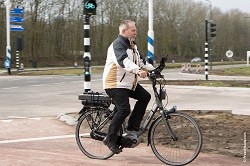Moving in the right direction for the protection of vulnerable road users
Efforts to reduce road accidents, such as the implementation of Intelligent Transport Systems (ITS), typically focus on vehicle and infrastructure design, as their starting point. But in the pursuit of success for transport systems that are cleaner, safer and more efficient, the needs of Vulnerable Road Users (VRU) – such as cyclists and pedestrians - have often been overlooked. With VRUs constituting 68 % of road fatalities in urban areas, alongside the EU’s commitment to halving road fatalities by 2020, there is a clear imperative to redress the balance. The EU-funded VRUITS project set out to more fully integrate VRUs into the equation by looking at actual human behaviour encountered across varied ITS set-ups. Testing human-centred approaches to road safety A comprehensive cost-benefits analysis of the various ITS approaches was undertaken with the objective of assessing the societal impacts of selected ITS, As Dr. Scholliers elaborates, ‘The impact assessment was made in two phases: a qualitative phase, during which 23 systems were analysed, and a quantitative phase, where a more detailed analysis was performed for 10 systems. The quantitative assessment is based on estimates of the quantitative effect for each of the mechanisms, accident trends and penetration rates.’ The accident trends were extracted from the EU’s CARE database, an initiative of its Road Safety Programme. In view of providing evidence-based recommended practices on how VRU can be integrated in Intelligent Transport Systems and on how HMI designs can be adapted to meet the needs of VRUs, VRUITS piloted ITS systems in the Netherlands and Spain. As the project coordinator Dr. Johan Scholliers explains, ‘The method for assessing the safety impact is based on the approach developed by the eIMPACT project, also funded by the EU. In this approach, the impact of ITS systems is assessed for nine mechanisms, which can affect road user behaviour, including indirect and long term effects.’ System tests were conducted in the Netherlands intended to increase intersection safety. Researchers piloted an ITS which was able to alert cyclists and car drivers to the risk of potential collision and additionally incorporated automatic car braking. During the tests, the system worked as expected with the Road Side Unit detecting about 80 % of the oncoming cyclists. The volunteer cyclists also reported safety benefits from the system. In the Spanish city of Alcala de Henares, pedestrian detectors and notification systems were tested to determine how they could enhance intersection safety. They found that while the technology offered potential, this was somewhat offset by the costs involved for integration into current infrastructure. Another Spanish study looked at how sensor controlled traffic lights could improve pedestrian mobility, finding that modifications resulted in pedestrian waiting time being reduced by 20 %. Additionally, a test to improve zebra crossing visibility increased safety by reducing by 5 % the number of pedestrians crossing the road on a red light. Delivering evidence based recommendations After analysing the 10 systems, VRUITS found that all evidenced an improvement in the safety and/or mobility and comfort of VRUs, with seven of them meriting the cost of implementation. Based on the accumulated evidence, the project was able to recommend clear actions to be taken by policy makers and industry. Those recommendations were ranked factoring in mitigating external factors such as likely societal impact, the legal framework, prevailing infrastructure, market readiness and data privacy. However, successful long-term implementation is only likely after further research is undertaken. As Dr. Scholliers explains, ‘Further research is needed to make the systems with a high potential benefit, better performing. For example, we need improved detection accuracy and better understanding of road user behavior, for systems such as pedestrian detection systems with emergency braking. We will also need further large scale testing to demonstrate benefits for the different stakeholders.’ For now, researchers in Spain and The Netherlands, as well as industry, are building on the research results. Indeed, one of the Spanish pilots conducted by the technology integration company, SICE, has resulted in the creation of the SafeCross product which helps pedestrians with reduced mobility safely cross the road.
Keywords
VRUITS, smart cities, intelligent transport systems, vulnerable road users, road safety, pedestrian safety, bicyclist safety, driver safety, mobility, traffic




